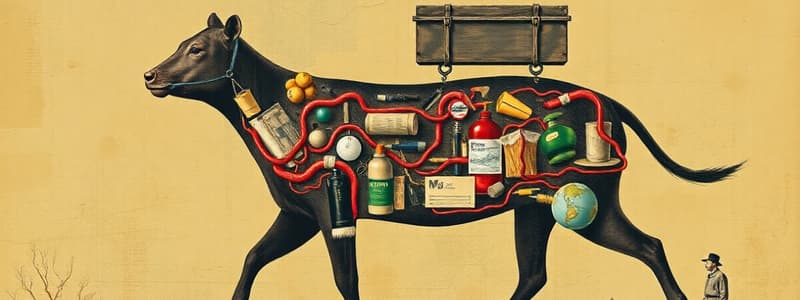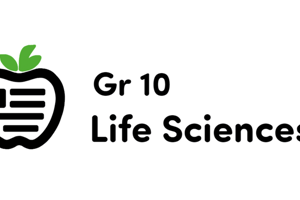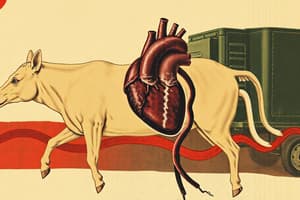Podcast
Questions and Answers
What is a significant advantage of having a double circulatory system?
What is a significant advantage of having a double circulatory system?
- It maintains a steep concentration gradient for gas exchange. (correct)
- It allows for lower blood pressure throughout the entire body.
- It facilitates a single pathway for blood flow.
- It ensures mixing of oxygenated and deoxygenated blood.
How does the double circulatory system benefit tissues in multicellular organisms?
How does the double circulatory system benefit tissues in multicellular organisms?
- It allows oxygen to be delivered at a lower pressure to all cells.
- It reduces the distance blood must travel within the body.
- It enables consistent oxygen supply by maintaining high metabolic rates. (correct)
- It prevents oxygen depletion by increasing blood volume.
What is the consequence of lower pressure in the pulmonary circulation?
What is the consequence of lower pressure in the pulmonary circulation?
- Greater efficiency in delivering oxygen to tissues.
- Increased probability of oxygen entering the bloodstream.
- Higher risk of blood clots forming in the lungs.
- Protection of the fragile pulmonary capillary network. (correct)
What is a disadvantage of the single circulatory system found in fish?
What is a disadvantage of the single circulatory system found in fish?
Why is high pressure in systemic circulation important?
Why is high pressure in systemic circulation important?
What is the primary reason that a circulatory system is necessary for animals with a high metabolic rate?
What is the primary reason that a circulatory system is necessary for animals with a high metabolic rate?
Which feature is essential for overcoming the limitations of diffusion in circulatory systems?
Which feature is essential for overcoming the limitations of diffusion in circulatory systems?
In mammals and birds, what does the term 'double circulation' refer to?
In mammals and birds, what does the term 'double circulation' refer to?
What is the role of the heart in the circulatory system?
What is the role of the heart in the circulatory system?
Why can single-celled organisms depend solely on diffusion for their nutrient and gas exchange needs?
Why can single-celled organisms depend solely on diffusion for their nutrient and gas exchange needs?
How do circulatory systems benefit animals that need to regulate a constant body temperature?
How do circulatory systems benefit animals that need to regulate a constant body temperature?
What is a key component of a mass transport system in animals?
What is a key component of a mass transport system in animals?
Which statement accurately describes the importance of having a closed circulatory system?
Which statement accurately describes the importance of having a closed circulatory system?
What is the primary function of the circulatory system in mammals and birds?
What is the primary function of the circulatory system in mammals and birds?
Which characteristic distinguishes mass transport systems from simple diffusion?
Which characteristic distinguishes mass transport systems from simple diffusion?
Why do larger, multicellular organisms require a circulatory system while single-celled organisms do not?
Why do larger, multicellular organisms require a circulatory system while single-celled organisms do not?
What major function does the respiratory system serve in relation to the circulatory system?
What major function does the respiratory system serve in relation to the circulatory system?
In a double circulatory system, what advantages does closed circulation offer over open circulation?
In a double circulatory system, what advantages does closed circulation offer over open circulation?
Flashcards are hidden until you start studying
Study Notes
Importance of Circulation in Animals
- Animals possess a small surface area to volume ratio, which necessitates a transport system for efficient nutrient delivery to cells, as diffusion alone is inadequate over longer distances.
- The heart is essential for pumping blood, facilitating the transport of nutrients and oxygen through the circulatory fluid (blood) while following pressure gradients to ensure mass flow throughout the body.
- Circulatory systems efficiently supply glucose, amino acids, and hormones to all body parts, vital for high metabolic rates and energy demands.
- Animals require constant body temperature regulation, with cells consuming significant oxygen and nutrients while producing carbon dioxide that needs removal.
Transport Systems in Small Organisms
- In single-celled organisms, oxygen and nutrients can diffuse directly into cells from the environment, as well as waste products, due to the small diffusion distance.
- These organisms have a large surface area to volume ratio, and their low metabolic demands do not necessitate temperature regulation, making diffusion adequate for their needs.
Features of Mass Transport Systems
- A mass transport system consists of structures that transport substances within a fluid along designated pathways.
- The respiratory system utilizes large surface areas, like lungs or gills, to facilitate effective gas exchange beyond mere diffusion.
- The heart generates pressure necessary for mass flow, transporting substances from areas of high pressure to low pressure, effectively overcoming the limitations of diffusion.
- A network of branching vessels directs substances to specific body parts, ensuring targeted delivery.
- Blood acts as a suitable transport medium, dissolving oxygen, nutrients, and waste products for efficient movement throughout the body.
Circulatory System in Mammals and Birds
- Mammals and birds possess a closed double circulatory system, where blood is confined to vessels and circulates through the heart twice during each complete circuit around the body.
- Blood is pumped from the heart to the lungs for oxygenation and then sent to the rest of the body, ensuring effective nutrient and oxygen delivery.
Advantages of a Double Circulatory System
- Separation of oxygenated and deoxygenated blood maintains a steep concentration gradient of oxygen in the lungs and tissues, enhancing gas exchange, crucial for high metabolic demands in multicellular organisms.
- Allows for different pressure levels: systemic circulation operates under relatively higher pressure to ensure efficient distribution of glucose and oxygen to tissues, including the brain. The lower pressure in the pulmonary circuit protects delicate capillary networks within the lungs from damage.
Transport System in Fish
- Fish exhibit a single circulatory system where blood passes through the heart once for each complete circuit of the body, limiting oxygen delivery efficiency.
Disadvantages of Single Circulation in Fish
- Mixing of oxygenated and deoxygenated blood reduces the effective concentration gradient for oxygen transport.
- A decline in blood velocity and pressure occurs after leaving the gills, leading to slower oxygen delivery to tissues.
- The low blood pressure in the single circulation is insufficient for efficient kidney function as observed in mammals.
Importance of Circulation in Animals
- Animals possess a small surface area to volume ratio, which necessitates a transport system for efficient nutrient delivery to cells, as diffusion alone is inadequate over longer distances.
- The heart is essential for pumping blood, facilitating the transport of nutrients and oxygen through the circulatory fluid (blood) while following pressure gradients to ensure mass flow throughout the body.
- Circulatory systems efficiently supply glucose, amino acids, and hormones to all body parts, vital for high metabolic rates and energy demands.
- Animals require constant body temperature regulation, with cells consuming significant oxygen and nutrients while producing carbon dioxide that needs removal.
Transport Systems in Small Organisms
- In single-celled organisms, oxygen and nutrients can diffuse directly into cells from the environment, as well as waste products, due to the small diffusion distance.
- These organisms have a large surface area to volume ratio, and their low metabolic demands do not necessitate temperature regulation, making diffusion adequate for their needs.
Features of Mass Transport Systems
- A mass transport system consists of structures that transport substances within a fluid along designated pathways.
- The respiratory system utilizes large surface areas, like lungs or gills, to facilitate effective gas exchange beyond mere diffusion.
- The heart generates pressure necessary for mass flow, transporting substances from areas of high pressure to low pressure, effectively overcoming the limitations of diffusion.
- A network of branching vessels directs substances to specific body parts, ensuring targeted delivery.
- Blood acts as a suitable transport medium, dissolving oxygen, nutrients, and waste products for efficient movement throughout the body.
Circulatory System in Mammals and Birds
- Mammals and birds possess a closed double circulatory system, where blood is confined to vessels and circulates through the heart twice during each complete circuit around the body.
- Blood is pumped from the heart to the lungs for oxygenation and then sent to the rest of the body, ensuring effective nutrient and oxygen delivery.
Advantages of a Double Circulatory System
- Separation of oxygenated and deoxygenated blood maintains a steep concentration gradient of oxygen in the lungs and tissues, enhancing gas exchange, crucial for high metabolic demands in multicellular organisms.
- Allows for different pressure levels: systemic circulation operates under relatively higher pressure to ensure efficient distribution of glucose and oxygen to tissues, including the brain. The lower pressure in the pulmonary circuit protects delicate capillary networks within the lungs from damage.
Transport System in Fish
- Fish exhibit a single circulatory system where blood passes through the heart once for each complete circuit of the body, limiting oxygen delivery efficiency.
Disadvantages of Single Circulation in Fish
- Mixing of oxygenated and deoxygenated blood reduces the effective concentration gradient for oxygen transport.
- A decline in blood velocity and pressure occurs after leaving the gills, leading to slower oxygen delivery to tissues.
- The low blood pressure in the single circulation is insufficient for efficient kidney function as observed in mammals.
Studying That Suits You
Use AI to generate personalized quizzes and flashcards to suit your learning preferences.





